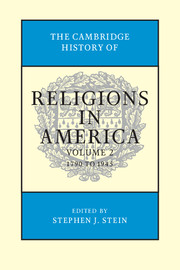Book contents
- Frontmatter
- Contents
- Contributors
- Editor's Introduction
- SECTION I RELIGION IN NORTH AMERICA
- SECTION II RELIGIONS IN THE NEW NATION, 1790–1865
- SECTION III CHANGING RELIGIOUS REALITIES
- 11 Diversity, Revival, Rivalry, and Reform: Protestant Christianity in the United States, 1800–1950
- 12 American Catholics, 1800–1950
- 13 American Judaism, 1820–1945
- 14 Formation and Consolidation of African American Religious Communities, 1865–1945
- 15 Eastern Orthodox Christianity in America
- 16 New Religious Movements
- 17 American Indian Religions in America, 1790–1945
- 18 Why Muslims Matter to American Religious History, 1730–1945
- 19 Asian Religions in the United States: The Role of the 1893 World’s Parliament of Religions in Shaping an Evolving Pluralist Ideology
- 20 Metaphysical Movements
- SECTION IV RELIGIOUS RESPONSES TO MODERN LIFE AND THOUGHT
- SECTION V COMPARATIVE ESSAYS
- SECTION VI RELIGION AND DIVERSE AREAS
- Index
- References
17 - American Indian Religions in America, 1790–1945
from SECTION III - CHANGING RELIGIOUS REALITIES
Published online by Cambridge University Press: 28 July 2012
- Frontmatter
- Contents
- Contributors
- Editor's Introduction
- SECTION I RELIGION IN NORTH AMERICA
- SECTION II RELIGIONS IN THE NEW NATION, 1790–1865
- SECTION III CHANGING RELIGIOUS REALITIES
- 11 Diversity, Revival, Rivalry, and Reform: Protestant Christianity in the United States, 1800–1950
- 12 American Catholics, 1800–1950
- 13 American Judaism, 1820–1945
- 14 Formation and Consolidation of African American Religious Communities, 1865–1945
- 15 Eastern Orthodox Christianity in America
- 16 New Religious Movements
- 17 American Indian Religions in America, 1790–1945
- 18 Why Muslims Matter to American Religious History, 1730–1945
- 19 Asian Religions in the United States: The Role of the 1893 World’s Parliament of Religions in Shaping an Evolving Pluralist Ideology
- 20 Metaphysical Movements
- SECTION IV RELIGIOUS RESPONSES TO MODERN LIFE AND THOUGHT
- SECTION V COMPARATIVE ESSAYS
- SECTION VI RELIGION AND DIVERSE AREAS
- Index
- References
Summary
A history of American Indian religions in America must first acknowledge that Indian religious experience is different from the practices of the organized religions that are generally studied in American history. Indian religions are place based, drawing spiritual power from specific aspects of the landscape. Their senses of spirituality come from an intimate relationship between humans and forces in the environment – winds, storms, the movements of animals, the flow of rivers, and significant rock formations in the landscape, because rocks may represent events that occurred in the formation of their worlds. In this sense religion is a part of life, and environment is the source of spirituality.
Given the widely varying environments in which Indians lived throughout North America in 1790, however, ideas about spirituality took greatly varying forms. Among the hunting people of the Great Plains, men established their individual identities by seeking visions in isolated places and demonstrated their powers in warfare and hunting. Pueblo peoples in their agriculturally based societies believed that humans have a causal role in maintaining the world. Their ceremonial cycles promoted human fertility and growth of crops.
This sense of human agency, the ability of human beings to influence the forces of the natural world, is a defining characteristic of native religions and one of the causes of conflict in the encounters of Christian missionaries with native people in the new American nation. One manifestation of individual power that affects other humans is the practice of witchcraft.
- Type
- Chapter
- Information
- The Cambridge History of Religions in America , pp. 369 - 392Publisher: Cambridge University PressPrint publication year: 2000



